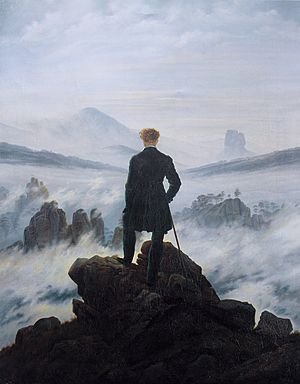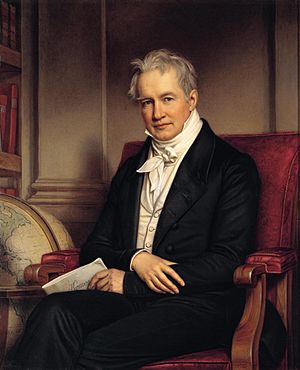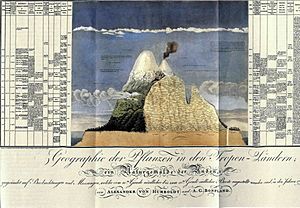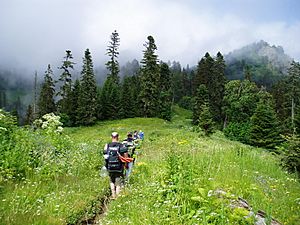Humboldtian science facts for kids

Humboldtian science is a way of studying nature that became popular in the 1800s. It is named after a famous German scientist, explorer, and naturalist named Alexander von Humboldt. A historian named Susan Faye Cannon first used the term "Humboldtian science" in 1978.
Humboldt was special because he could look at lots of facts and measurements (called empirical data) and also see how everything in nature was connected. This way of thinking helped define how we study plants and where they grow today. Humboldtian science was one of the first methods to study both living things (like plants) and non-living things (like rocks or weather) together.
A key idea in Humboldt's work was understanding how plants and their surroundings are linked. He called this "terrestrial physics." Scientists before him, like Carl Linnaeus, didn't focus on these connections as much. Humboldtian science also believed in a "general equilibrium of forces." This means that many different forces in nature are always interacting, but they all balance each other out. Humboldt's ideas helped future scientists understand the importance of studying living things and their environment at the same time.
Contents
Who Was Alexander von Humboldt?
Alexander von Humboldt was born in Berlin, Germany, in 1769. In the 1790s, he worked as a mining official. But he loved science and exploring! In 1797, he quit his job to focus on gathering scientific knowledge and tools.
Humboldt was quite wealthy, which helped him follow his passion for Romanticism. This was a time when people were very interested in nature, emotion, and discovery. He bought many scientific instruments and built a large library.
In 1799, with permission from King Charles IV of Spain, Humboldt set off for South America and New Spain (which is now Mexico). He took all his tools and books with him. His goal was to see how nature's forces worked together and to understand the "unity of nature."
Humboldt returned to Europe in 1804 and was celebrated as a hero. He wrote about his discoveries in a huge 30-volume book called Personal Narrative of Travels to the Equatorial Regions of the New Continent. Charles Darwin even took this book with him on his famous voyage on the HMS Beagle. Humboldt spent most of the rest of his life in Europe. He did go on a short trip to Siberia and Russia in 1829. His last major work was a book called Kosmos, which means "Cosmos: Sketch for a Physical Description of the Universe."
What Makes Humboldtian Science Special?
Humboldtian science includes Alexander von Humboldt's own work and the work of many other scientists in the 1800s. Susan Cannon is known for creating the term "Humboldtian science."
Cannon pointed out four main things that made Humboldtian science different from earlier ways of doing science:
- It insisted on being very accurate with all scientific tools and observations.
- Scientists were open-minded and didn't just stick to old theories.
- It used new tools like isomaps (maps showing lines of equal value), graphs, and ways to understand errors in measurements.
- These accurate methods and tools were used to study real, changing things in nature, not just experiments in a lab.
Humboldt's "Terrestrial Physicist"
Humboldt was very dedicated to what he called 'terrestrial physics.' This new scientific approach needed a new kind of scientist. Humboldt believed scientists should change from just studying nature (naturalists) to understanding its physical laws (physicists).
Humboldt saw himself as a "scientific traveler," not just an explorer. He wanted to measure things accurately that explorers might have reported incorrectly. For Humboldt, a terrestrial physicist's job was to study how all the physical forces in nature were connected.
To do this, a Humboldtian terrestrial physicist needed many precise tools. These included things like:
- Chronometers (for time)
- Telescopes (for distant objects)
- Sextants (for angles and navigation)
- Microscopes (for tiny things)
- Magnetic compasses (for direction)
- Thermometers (for temperature)
- Hygrometers (for humidity)
- Barometers (for air pressure)
- Electrometers (for electricity)
- Eudiometers (for gas analysis)
It was also important to have several different models of each tool. This way, scientists could compare measurements and make sure they were correct.
Humboldt's Idea of Nature's Balance
A main idea in Humboldtian science is the "general equilibrium of forces." This means that the more forces we measure accurately across the Earth, the better we understand how nature is organized.
Humboldt's trip to the Americas led to many discoveries that showed his ideas about this balance. He created a famous graphic called the Tableau physique des Andes ("Physical Profile of the Andes"). This single chart tried to show all the physical forces he observed on his journey, from living organisms to electricity.
Humboldt's study of plants also shows how Humboldtian science moved beyond older ways of thinking. His work on plants further illustrates the idea of equilibrium and how all parts of nature are connected. While he looked at the physical features of plants, he was mostly interested in the hidden links and relationships between them.
Humboldt's Lasting Impact
The American writer Ralph Waldo Emerson once called Humboldt "one of those wonders of the world." He said Humboldt appeared "as if to show us the possibilities of the human mind."
Many people consider Humboldt to be one of the first true ecologists. Ecology is the study of how living things interact with each other and their environment. Humboldt's work went far beyond his own trips and discoveries. Scientists from all over the world joined in his projects.
Humboldt's ideas, especially those about natural philosophy (the study of nature), helped bring more European money and travelers to Spanish America in the early 1800s. Humboldtian science created useful maps and statistics. It also gave European and local societies new ways to understand and "re-imagine" America. The long-term effect of Humboldtian science was that it helped change how knowledge and different scientific fields were organized in the early 1800s. This led to the rise of "natural history" from "natural philosophy."
See also
- History of biology
- History of ecology
- History of geography
- History of geology
- Romanticism
- Romanticism in science




